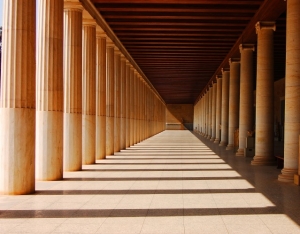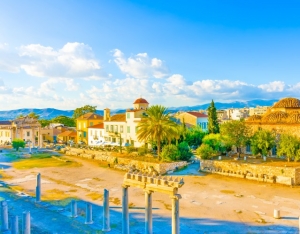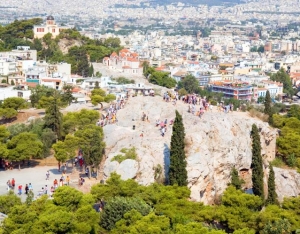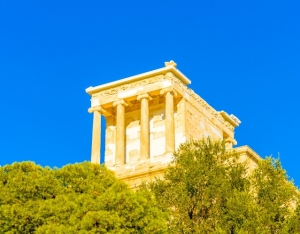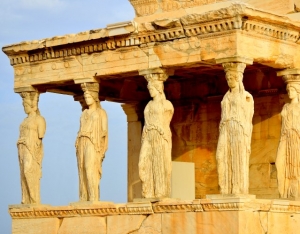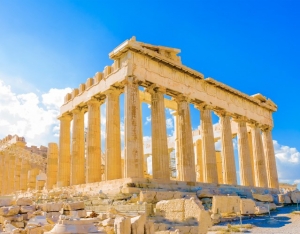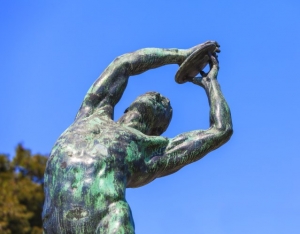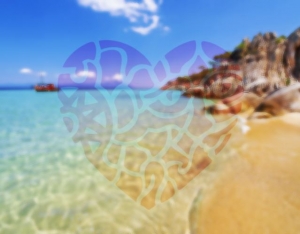Thodoris Bgenopoulos
Within the archaeological site of Ancient Agora, you will find the very famous Stoa of Attalos. It was constructed around 150 BC and it was a donation to Athens by king Attalos II of Pergamon, whose name carries.
The building of the arcade had two floors and a length of 116 meters, while it was surrounded by Ionic and Doric columns. The Arcade housed over 40 shops and was something like a mall at the time.
The Stoa of Attalos was destroyed by the Heruli in 267 AD and restored in its present form in 1956. Today the Stoa of Attalos is a museum, housing the findings from the excavations in the Ancient Agora.
The Ancient Agora of Athens is located north from the Acropolis, under the shadow of the holy rock. Besides being the central trade space, the Ancient Agora was also a space where people gathered, discussed and engaged in policy-making. The administrative buildings of the city of Athens were built here, such as the old Parliament House (where the House met) and the Vasileios Stoa - Royal Arcade (seat of Lord King).
Agora was initially destroyed by the Persians in 480 BC and radically changed form. Along with the prime of the Athenian democracy, comes also the prime of the Agora, as new buildings such as the Dome, the new Parliament House, the Temple of Hephaestus and others are constructed.
The area of Agora remained intact until 86 BC, when the Roman Sulla invaded Athens, causing major damage. Agora itself suffers greatly, but thanks to the help of many rulers from other regions (such as the King Attalos of Pergamon, who donates the Stoa of Attalos); it is soon restored with new, even more impressive buildings. The final blow to the Ancient Agora was given by the raid of the Heruli (267 AD). Almost all buildings were destroyed (oddly for unknown reason the Temple of Hephaestus is saved) and lead to the gradual abandonment of the area.
Northwest of the Acropolis is a hill that probably took its name from the god Mars-Ares and is therefore called Areos Pagos. In ancient times here the judiciary of the House of the Areios Pagos (one of the courts of Athens) met. This name remained until the modern times and the Greek Supreme Court is now called Areios Pagos.
It is upon this hill that in 51 AD Christianity was declared to the Athenians by Apostle Paul. It is said that this sermon made Dionysius-the so called Aeropagitis- to convert, and become the first bishop of Athens and later patron saint of the city.
The Temple of Athena Nike is upon the rock of Acropolis, south of the Propylaea. The temple you have the chance to see today, was built around 426-421 BC according to the plans of Kalikratis, an architect who was also responsible for the Parthenon. It was created in the same place where older temples once existed, again dedicated to Athena Nike.
The Temple of Athena Nike is quite small, of Ionic order and made entirely by the famous Pentelic marble. Above the architrave there is a frieze depicting victorious battles of the Greeks, under the gaze of the Olympian gods. According to tradition and the writings of Pausanias, inside the temple there was a statue of the goddess Athena Nike but it was wingless (Apteros) so that she could not fly away. In this way she would live forever in Athens, protecting the city.
During the Ottoman rule, the Turks demolished the temple and used its pieces to build a fortified tower. Once the independent Greek state was created, after the Greek Revolution, the tower was demolished and the temple was restored to its original form.
Propylaea, located on the west side of the Acropolis, serve as an entrance to the site of the Acropolis. They acquired their present form during the "Golden Age of Pericles", when most great works of the Acropolis took place. Propylaea were built by the famous architect Mnesicles, in the years 437-432 BC but were never completed, as the Peloponnesian War broke out. They were designed in such a way as to awe the visitor that climbs the stairs and enters the sacred space.
Propylaea are built with a special mix of Doric and Ionic order and are made from the famous Pentelic marble. Their project inspired many later architects who created commensurate buildings in various European cities.
In antiquity, the northern part of Propylaea hosted an art gallery with top painters of the time, while on the south side of the visitor can admire the Temple of Athena Nike.
In the days of the Frankish empire, the Propylaea were the Frankish ruler’s residence, while during the Turkish rule they were the headquarters of the Turkish garrison. It is then that a part of the building is converted to gunpowder storage, which explodes in 1640, causing considerable damage to the monument.
After the Greek Revolution, the later buildings were demolished and the space was attempted to obtain the form he had in antiquity.
The Erechtheum is an important temple at the top of the Acropolis, worldwide famous for its stunning Caryatids. According to mythology, this is the point where Athena and Poseidon quarreled over who will be the patron god of the city, with Athena being the final winner and thus giving her name to the city.
The temple was built between 421 and 406 BC, it is Ionic and quite peculiar, being built on two levels due to terrain's morphology. The temple took its name from the mythical king Erechtheus that is identified by some with Poseidon. It's construction material is the famous Pentelic marble and in the temple was a statue of the goddess Athena as well as a part of the sacred olive tree that the goddess gave to the Athenians. The temple was actually divided into two parts, one dedicated to Athena and another one to Poseidon, as Athenians did not want to dissatisfy any of the two gods.
Its worldwide fame stems, among others, from its external decoration and especially the Caryatids: Six female statues of exceptional beauty support on their heads the roof of the south portico of the Erechtheion. The Caryatids were probably symbolic guardian patrons of where according to legend was the tomb of Cecrops, the first king of Athens.
Today, the Caryatids are separated. Five of them can be found in a special hall in the new Museum of Acropolis, waiting for their sixth sister that is in the British Museum, along with other ancient marbles that Lord Elgin took from Greece during the Ottoman occupation.
The Parthenon lies at the top of the rock of the Acropolis and is the most famous temple worldwide. Its construction begun in 448 BC and the Parthenon we have today was inaugurated in 438 BC. Since goddess Athena was the patron of the city of Athens, the temple was dedicated to her. Inside the Parthenon there was once a statue of the goddess, made of gold and ivory.
The completion of the Parthenon was a collaboration between the architects Iktinos and Kallikratis, as well as the famous sculptor Phidias, who was responsible for both the sculptural decorations and the famous statue of Athena that is unfortunately lost today.
The temple of Parthenon is a unique architectural achievement that leaves every visitor speechless. The impressive and majestic view of the temple is achieved by using a series of mathematical ratios. Their application in the construction of the Parthenon, along with a series of special features (such as the slight inclination of the columns towards the interior of the temple) have created an aesthetically perfect result.
The temple is of Doric order and is one of the few ancient temples that were entirely made of marble. Actually, it worth noting that the famous Pentelic marble was used for its construction. The temple's metopes (fronts), the pediments and the frieze running around the Parthenon, are decorated with impressive embossed depictions. The sculptures have subjects taken from both Greek mythology (Titanomachia, Birth of Athena from the head of Zeus) and real life (Panathenaia), which are carved with an unparalleled technique that gave the Parthenon an unrivaled beauty.
In order to protect the Parthenon from the ravages of time and environment, many of its parts are gradually being replaced with replicas. The original parts of the Parthenon can still be admired in the modern New Acropolis Museum.
The Parthenon retained its original form until 5the century AD, when it was converted into a church, while in the Ottoman period it became a mosque. In 1687 when the Henets sieged the Acropolis, the Parthenon was hit by a shell that caused a great part of it to collapse. However, it seems that the monument was destined to suffer even more. Lord Elgin's looting caused new damage to the temple, striping it out of several sculptures that are now (together with one Caryatid) in the British Museum. The first attempts to restore the Parthenon begun around 1,900, while the maintenance and protection of this unique to humanity monument, continues unabated to this day.
The Acropolis of Athens is a rocky hill, almost in the center of the city and located about 70 meters above it.
In every Greek city there was always an Acropolis, which was actually the fortress on the edge of town (acro=edge polis=town), where the residents found shelter in case of raids. Yet, thanks to its unique buildings and its huge historical and cultural heritage, the Acropolis of Athens stands out from the rest and is simply called the Acropolis.
The rock of Acropolis indicates that life was prevalent there already from 3,000 BC, while the rock itself was a natural fortress for those residing there throughout the years. At the top of the hill, used to be the palace of the ruler of the city. Now in the same place you will find the Erechtheion. Gradually the Acropolis became a place of worship and upon the rock many buildings were constructed, including the temple dedicated to Athena.
After the defeat of the Persians, during the so-called Golden Age of Pericles, many constructions took place in the Acropolis: the Parthenon, the Erechtheion, the Propylaea and the Temple of Athena Nike, all of them are buildings of unique beauty that make the Acropolis famous worldwide. Millions of people visit the Acropolis every year to witness its splendor first hand, and then visit the New Acropolis Museum to learn its history.
Athens (and the wider region of Attica) is a city where you can literally find and do everything. Wonderful beaches are almost everywhere. There, besides swimming, you can enjoy your favorite water sports. Yet, if the surface of the sea is not enough for you, you can dive and explore the beautiful seabed.
If you are a mountain-type, fear not. Beautiful high mountains surround Athens (Parnitha, Hymettus), inviting you to enjoy hiking and climbing. If walking is too exhausting or you simply want something different, Attica has a plethora of riding clubs, where you can ride a horse.
If organized entertainment is your thing, you will also find several options here. Vast amusement parks and water parks for all ages. Fields for any sport you like, from football and basketball (the Greek favorites) up to golf. If you are the extreme type, Attica has kart racing tracks where you can reach incredible speeds, having as rival either the timer or your friends, and Paintball fields ready to shelter memorable battles.
In short, Athens and Attica have many suggestions in different regions, you just decide what you prefer!
Asteras Glyfadas beach is in Glyfada, 20 km from the center of Athens, in the southern suburbs.
Asteras Glyfadas beach is well organized, has a capacity of 5,000 people and operates with admission ticket. The beach has a unique sandy beach, gorgeous blue waters, sun beds, umbrellas and very good beach bars. It is ideal for families with children as it has special recreational spaces for kids, in and out of water, offering also the possibility of childcare upon request. For grown-ups there are also beach volley and beach soccer courts.
Right next to the beach you will find Balux Cafe and its wonderful pool (if you are not into salty water), as well as excellent restaurants where you can enjoy fantastic meals.
More information concerning Asteras Glyfadas beach, can be found in www.asterascomplex.com.

